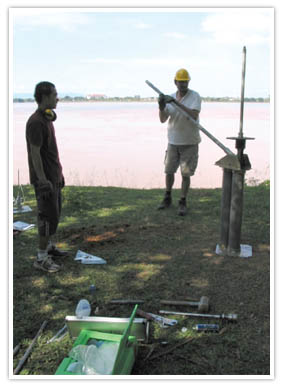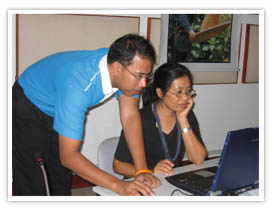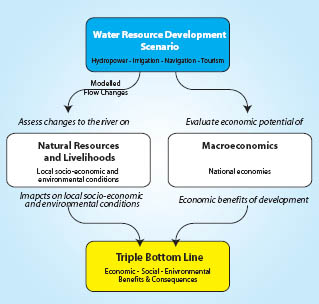IBFM puts triple bottom line assessment into practice
Wherever there is water there are people wanting to use it for their benefit. This is natural state of affairs and in this respect the Lower Mekong Basin is no different to any other river basin in the world. What is different is that the water resources of the Mekong are largely untapped and that the ecological health of the river is still robust. This provides the member countries of the MRC with an opportunity to plan development guided by the positive and negative experiences of countries that have developed their water resources to a greater extent.

The countries of the Mekong River Basin have put sustainable development of the Mekong's water and related resources at the top of their economic agendas if they are to achieve their poverty alleviation goals, but they realise that this involves making trade-offs between the demands of competing sectors. These trade-offs could include between fisheries and hydropower, between the modifications to the natural flow of the river and the natural environment; between nations that share a common river basin.
The tools being developed under MRC’s Integrated Basin Flow Management (IBFM) initiative aim to provide policy makers and development planners from the riparian countries with information that will enable them to make decisions about water resource development in the light of the full spectrum of the benefits and costs these developments will bring to their people.
One lesson learned from past experiences is that while the benefits brought by developments are tangible in terms of factors such as revenue, increased food production, provision of electricity, improved navigation, and flood mitigation, the costs that are taken into account are often limited to the capital and operational costs of particular projects.
However, other impacts, such as possible damage to fisheries, wetlands, and the ecological health of the river system and consequent impacts of people living by the river, were not taken into account fully. This was partly because these can occur at some distance from the development site and partly because their manifestations can take years to come into effect.
The IBFM tool, taking these experiences into account, will provide a "triple bottom line" environmental, economic and social-assessment of the effects of future development projects. It captures the body of knowledge and experience accrued over the past four decades by scientists working the water-resource development field around the world to build a predictive method designed specifically for the particular circumstances of the Lower Mekong Basin.
The analysis is based on two factors;
(i) a deep understanding of the river
system, the resources it currently provides, the livelihoods
it supports, and its place in the culture and society of the
people who live in the basin; and
(ii) the ability to model, through computer simulations, how
developments will modify the hydrology and hydraulics the of
river basin and predict how these will in turn impact the physical,
biological and social characteristics of the system.

Results were analysed in a workshop held
at the MRC
Secretariat.
The early stages of IBFM, therefore, involved building this knowledge base and developing the computer software that could model the complexities of the flow in the Mekong River system and make accurate predictions of changes to the flow that could result from human interventions to the system.
Because understanding the flow of the river (what volumes of water move where and when) lies at the core of IBFM, the first step was to provide a detailed description of hydrology of the basin that was understood and agreed by all the MRC Member States. This work, which was funded by the World Bank, was completed in 2004 and made available to the general public through the MRC publication, Overview of the Hydrology of the Mekong Basin.
Building the knowledge base of the river, involves a multidisciplinary team that included hydrologists, botanists, geomorphologists, biologists, sociologists, and economists.
Their work was initiated in 2005. The comprehensive analysis not only includes details of the geomorphology, ecology and the current human uses of the river, it also defines those factors that are indicative, or susceptible, to changing flows.
This 'holistic' approach brought together the ecological, economic and social aspects of development. It also brought to light the complex manner in which the physical character and biological character of the basin are closely interlinked and how they, in turn, interact with the livelihoods and way of life of the basin's inhabitants.

One of the early products of the IBFM research was a greater appreciation of the factors that control the natural variability of the Mekong, both in terms of the annual seasonal flux of the wet and dry seasons and the river's ephemeral physical features such as floodplains, channels, sand bars and islands. Understanding this natural variability provides a framework against which to set changes that may occur to the river system stemming from human interventions. For example, analysis of historical records of the annual flood volume and the size of annual flood peak shows that the magnitude of the annual flood-recession cycle has been remarkably consistent showing little variation since records were first taken over 80 years ago. Increasing or decreasing this variability could cause the character of the river to change.
A key element of this part of the work was continuous dialogue between the IBFM development team and various interested agencies, including the National Mekong Committees and other experts from the region. A series of stakeholder consultations will ensure that their invaluable experience is incorporated into the process and that their recommendations are taken into account the planning of the next stages of IBFM.
The work up to 2006 provided the raw ingredients needed to develop an IBFM methodology applicable to the Mekong. The next step is to take these ingredients and the feedback received from the other concerned bodies to develop a predictive tool. This will build on and refine the technical knowledge gained so far and, through models and expert tools, develop the “Mekong Method” for flow assessment.
The MRC will then be ready to analyse the impacts (both positive and negative) of agreed water resources development scenarios developed under the Basin Development Plan phase 2 which are of interest to the member countries.
Choose a newsletter: